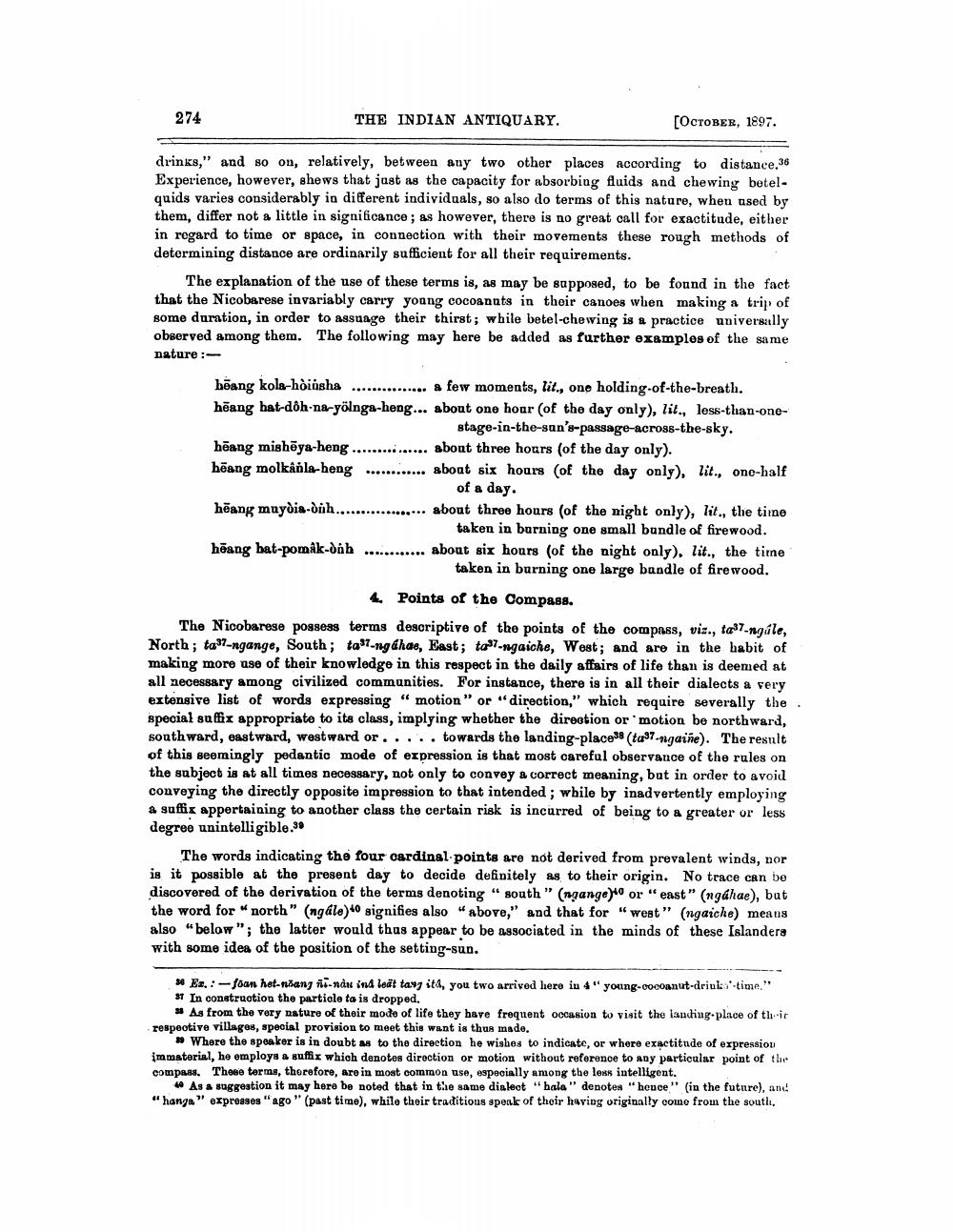________________
274
THE INDIAN ANTIQUARY.
[OCTOBER, 1897.
drinks," and so on, relatively, between any two other places according to distance.36 Experience, however, shews that just as the capacity for absorbing fluids and chewing betelquids varies considerably in different individuals, so also do terms of this nature, when used by them, differ not a little in significance; as however, there is no great call for exactitude, either in regard to time or space, in connection with their movements these rough methods of determining distance are ordinarily sufficient for all their requirements.
The explanation of the use of these terms is, as may be supposed to be found in the fact that the Nicobarese invariably carry young cocoanuts in their canoes when making a trip of some duration, in order to assuage their thirst; while betel-chewing is a practice universally observed among them. The following may here be added as further examples of the same nature:
bēang kola-hòisha ................ a few moments, lit., one holding-of-the-breath. hēang hat-doh-na-yölnga-heng... about one hour of the day only), lit., less-than-one
stage-in-the-san's-passage-across-the-sky. hoang mishāya-heng .............. about three hours (of the day only). hoang molkanla-heng ............ about six hours of the day only), lit., one-half
of a day. hēang muydia-ònh .................. about three hours (of the night only), lit., the time
taken in burning one small bundle of firewood. hõang bat-pomak dah .............. about six hours (of the night only). lit., the time
taken in burning one large bandle of firewood.
4. Points of the Compass. The Nicobarese possess terms descriptive of the points of the compass, vis., ta7-ngile, North; tam-ngange, South; ta37-ng áhao, East; ta37-ngaiche, West; and are in the habit of making more use of their knowledge in this respect in the daily affairs of life than is deemed at all necessary among civilized communities. For instance, there is in all their dialects a very extensive list of words expressing “motion " or "direction," which require severally the special suffix appropriate to its class, implying whether the direction or motion be northward, southward, eastward, westward or ..... towards the landing-places' (ta97-ngaine). The result of this seemingly pedantic mode of expression is that most careful observance of the rules on the subject is at all times necessary, not only to convey a correct meaning, but in order to avoid conveying the directly opposite impression to that intended; while by inadvertently employing & suffix appertaining to another class the certain risk is incurred of being to a greater or less degree unintelligible.
The words indicating the four cardinal points are not derived from prevalent winds, nor is it possible at the present day to decide definitely as to their origin. No trace can be discovered of the derivation of the terms denoting " south" (ngange)" or "east" (ngáhae), but the word for "north" (ngale)40 signifies also " above," and that for "west" (ngaiche) means also "below"; the latter would thus appear to be associated in the minds of these Islanders with some idea of the position of the setting-sun.
se Ez, :-foan het-nang tiinan ind leät tang it, you two arrived here in 4"young-cocoanut-driuk time." 97 In construction the particle ta is dropped.
* As from the very nature of their mode of life they have frequent occasion to visit the laughing place of this respective villages, special provision to meet this want is thus made.
• Where the speaker is in doubt as to the direction he wishes to indicate, or where exactitude of expressiou immaterial, he employs a sufix which denotes direction or motion without reference to any particular point of the compass. These terms, therefore, aro in most common use, especially among the loss intelligent.
As a suggestion it may here be noted that in the same dialect "hala" denotes "house" (in the future), and "hanga" expresses "ago" (past time), while their traditions speak of their having originally come from the south.




